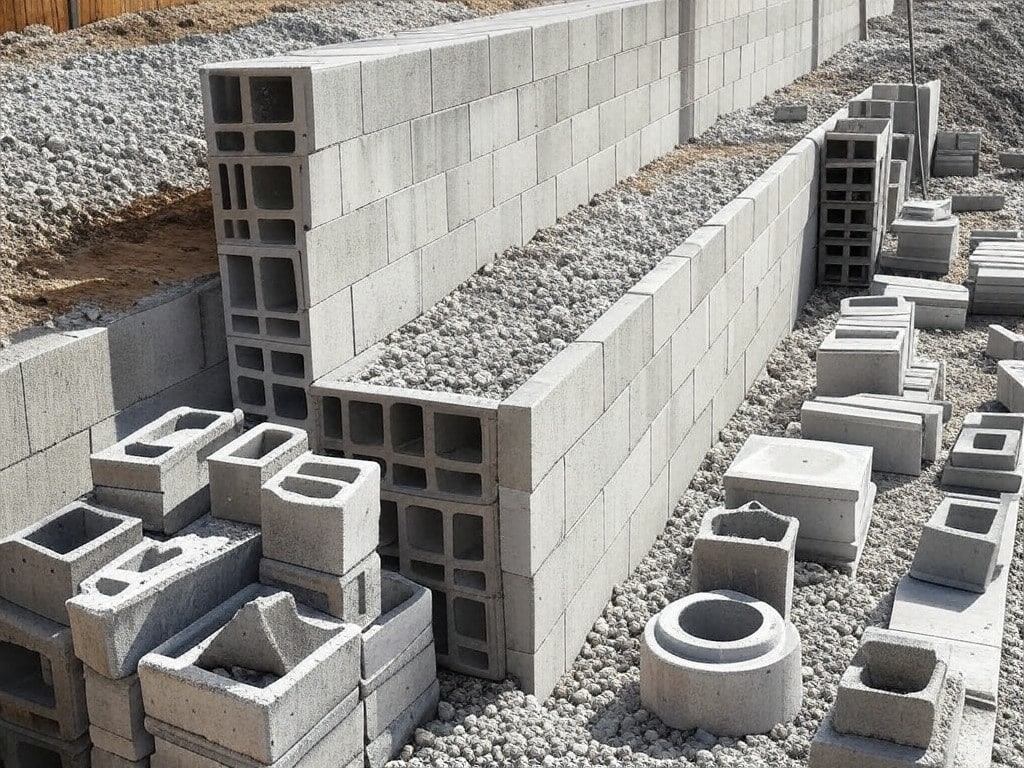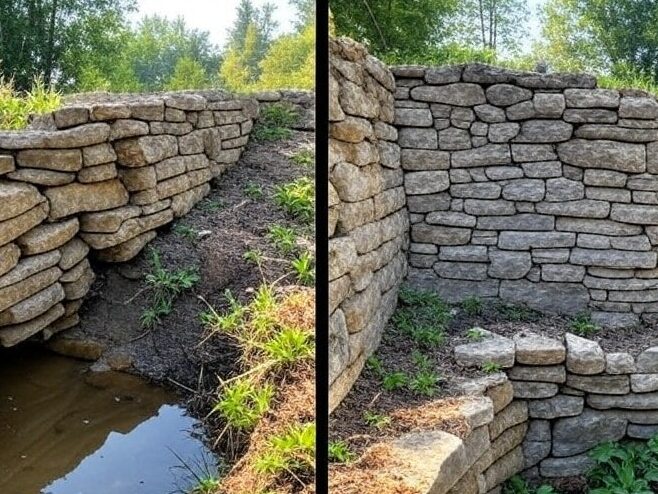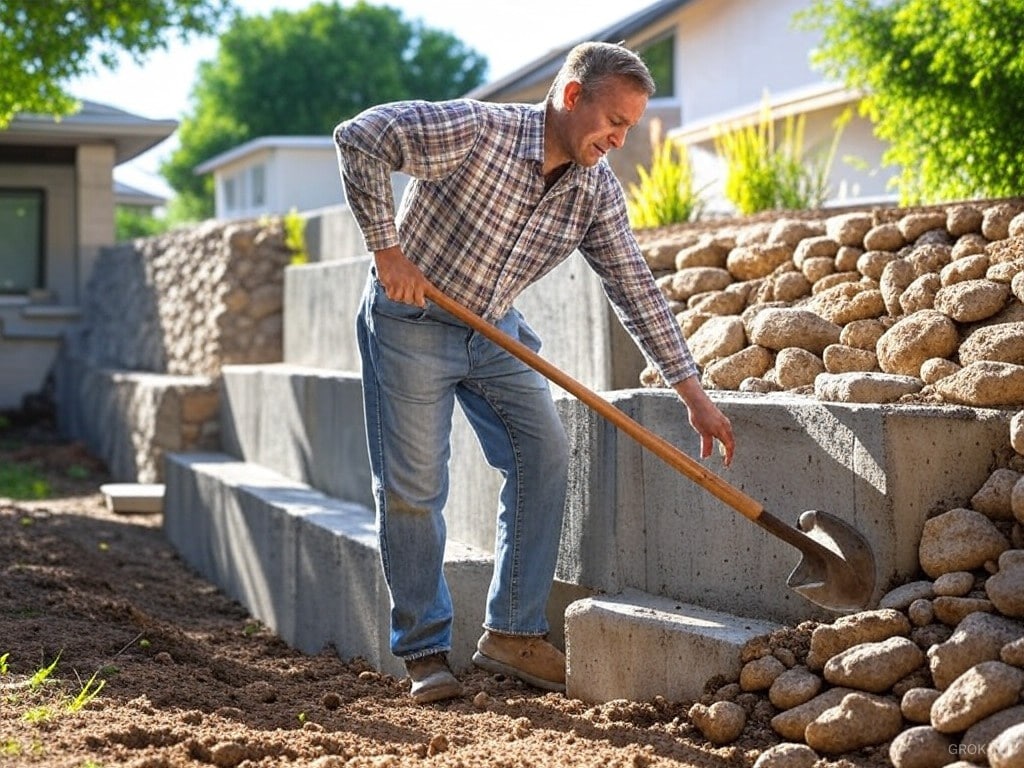Want to build a retaining wall? It’s a smart way to tackle erosion or just clean up your yard’s look. But if you don’t plan right, you’ll end up redoing it later.
Here’s the breakdown:
- How long it takes (varies, but don’t expect it done in a day)
- Materials you’ll need (blocks, gravel, and some muscle)
- Step-by-step how-to (dig, level, repeat—patience pays off)
- Tips to avoid rookie mistakes (because nobody wants a collapsing wall)
Get it right the first time, and you’ll save yourself a headache.
Understanding Retaining Walls: Types and Their Purposes
Before you get started, you’ll want to figure out what kind of retaining wall actually works for your situation. Different types serve different purposes, and picking the right one isn’t just about looks—it affects how long the project will take and whether your wall will still be standing years down the road.
Overview of Retaining Wall Types
There are various types of retaining walls, including:
- Gravity walls hold back soil just by being heavy—no fancy engineering needed. They’re your go-to for shorter walls and simpler projects.
- Cantilevered walls step it up with a reinforced concrete base, giving them more muscle for taller jobs where gravity walls might wobble.
- Anchored walls are the overachievers—they use cables drilled deep into the soil behind them, perfect when you need serious stability for tall or heavy-duty walls.
- Gabion walls are basically wire cages stuffed with rocks. They’re not the prettiest, but they’re champions at handling drainage and erosion.
- Segmental walls snap together like LEGO blocks (the heavy-duty kind). They’re sturdy but forgiving, which makes them a DIY favorite.
Choosing the Right Retaining Wall for Your Landscape
Selecting the right retaining wall depends on several factors:
- Soil stuff: Look, if your dirt’s more like beach sand than firm clay, you’re gonna need to put in extra work. Deeper footings, maybe some geogrid – otherwise your wall’s gonna tilt like the Tower of Pisa after a few rains.
- Height matters: Here’s the thing – once you go past waist-high, those basic stack-and-go walls stop being cute. Now you’re in “call an engineer” territory unless you want a landscaping disaster on your hands.
- Water woes: Water always wins, so plan for it. Some walls handle drainage naturally (gabions are basically all holes), while others… let’s just say I’ve seen what happens when you skip the weep holes. Not pretty.
- The looks department: At the end of the day, you’ve got to live with how this thing looks. Rough stone says “English garden,” clean concrete screams “modern,” and wood… well, good luck with that in ten years.
Why Retaining Wall Type Affects Construction Timeline
Each type of retaining wall has a different construction timeline. For example:
- Gravity walls: Can be completed quickly with stacked stones or blocks.
- Cantilevered and anchored walls: Require excavation, reinforcement, and curing time, taking several weeks to complete.
- Gabion walls: Are quicker to assemble but require heavy-duty mesh and filling with stones.
Key Materials Needed to Build a Durable Retaining Wall

Why Your Material Choices Matter
Let’s be real – skimping on materials is how retaining walls turn into expensive do-overs. Good quality stone or blocks might cost more upfront, but they’ll save you from that sinking feeling (literally) when your wall starts leaning after two seasons.
What You Actually Need to Build Something That Lasts
- Concrete blocks/stone: These are your wall’s backbone. Pick something that looks good too – you’ll be staring at it for years.
- Gravel & crushed stone: Not the glamorous part, but skimp here and you’ll get drainage problems. Ask me how I know.
- Steel reinforcements: Only if you’re building something taller than your ego (over 4 feet).
- Drainage pipe: Skip this and water will push your wall over like it’s made of cardboard.
- Backfill: Half gravel, half dirt – the wall’s cushion against shifting soil.
Tools That’ll Save Your Sanity
You could try building this with just a shovel and hope… or grab:
- A decent shovel (your back will thank you)
- Level & tape measure (unless “crooked” is your aesthetic)
- Compactor (stomping gravel with your boots gets old fast)
- Masonry saw (for when blocks don’t fit – they never all fit)
- Tamper (because gravity alone won’t pack things tight enough)
- Concrete mixer (if pouring – mixing by hand is a young person’s game)
The Hard Truth About Cheap Materials
That bargain bin stone? It’ll cost you triple in repairs when:
- Soil pressure cracks weak blocks
- Poor drainage washes out your foundation
- You’re redoing the whole thing in 5 years instead of 25
How Long Does It Take to Build a Retaining Wall?
How Long Does It Really Take to Build a Retaining Wall?
Honestly, it’s not one of those “weekend project” claims you see on DIY blogs. The timeline depends on:
What Actually Slows You Down
- Size and height: That cute little knee-high wall? Maybe a weekend. Anything taller than your waist suddenly needs serious foundations and reinforcements (read: more time).
- Materials: Fancy natural stone looks great but takes forever to fit together right. Those uniform concrete blocks? They practically snap together by comparison.
- Weather: Because nothing says fun like trying to set concrete in a downpour or during a freeze.
- Your dirt situation: Hit bedrock or pure clay? Congrats on your unexpected excavation adventure.
- Who’s working: Going solo? Triple whatever time estimate you have. Pros with a crew? They’ll finish before you’ve picked out your patio furniture.
Timeline for DIY vs. Professional Construction
| Wall Type | DIY Timeline | Professional Timeline |
|---|---|---|
| Small Gravity Wall (3 ft) | 2-3 Days | 1-2 Days |
| Medium Cantilever Wall (4-6 ft) | 5-7 Days | 3-4 Days |
| Large Reinforced Wall (Over 6 ft) | 2-4 Weeks | 1-2 Weeks |
Hiring professionals can significantly shorten the timeline due to experience, equipment, and workforce efficiency.
How Preparation Shortens the Retaining Wall Timeline
A well-prepared project can reduce delays. Preparation steps include:
- Gathering materials and tools in advance.
- Clearing and leveling the worksite before construction.
- Having drainage solutions planned and ready.
Common Mistakes to Avoid in Retaining Wall Construction

The Biggest Mistake That Topples Retaining Walls? Bad Drainage
Let me tell you, nothing ruins a retaining wall faster than water buildup. When that moisture gets trapped behind your wall, it’s like a slow-motion shove—eventually, cracks appear, the wall bulges, and before you know it, you’re staring at a collapsed mess.
How to Actually Keep Water from Wrecking Your Wall:
- Drainage pipes are non-negotiable. Run a perforated pipe along the base to give water an escape route.
- Backfill with gravel, not dirt. Dirt holds water; gravel lets it flow.
- Weep holes are your friend. If you’re using concrete or masonry, these little gaps let water trickle out instead of building up pressure.
Skip drainage, and you might as well start planning your wall’s funeral.
Building on Unstable Soil? Good Luck.
If your soil is sketchy—too sandy, too clay-heavy, or just plain loose—your wall is already fighting a losing battle. Without proper prep, it’ll shift, settle, or just give up entirely.
How to Not Regret Your Life Choices Later:
- Compact the base like your wall’s life depends on it (because it does).
- Geogrid reinforcement isn’t just for pros. Taller than 3 feet? You need this.
- When in doubt, test the soil. If it feels questionable, it probably is.
Even the best-built wall will fail if the ground beneath it can’t hold up its end of the bargain.
Picking the Wrong Materials? Enjoy Your Do-Over.
Not all blocks, stones, or timbers are built for heavy lifting. Use something too weak, and your wall will crumble under pressure—literally.
How to Avoid a Material Meltdown:
- Concrete blocks or natural stone? Make sure they’re rated for retaining walls, not just decoration.
- That bargain-bin “wall block” special? Hard pass if it’s not structural.
- Short garden wall vs. slope-holding beast? They need totally different reinforcements.
Cheap out now, and you’ll pay double to fix it later.
Expert Tips for a Reliable and Efficient Retaining Wall Project

Prepping Your Site: Don’t Skip These Steps!
Before you even think about stacking that first block:
- Call 811 – Hitting a gas line will ruin your project (and possibly your day)
- Mark your layout with spray paint – Because “eyeballing it” leads to wavy walls
- Compact that base like your marriage depends on it – Loose soil equals a leaning wall
For anything over 3 feet? Get a soil engineer. That $300 consultation could save you $3,000 in repairs.
Keeping Your Wall Strong Year After Year
- Spring checkup: Look for cracks or bulges after winter thaw
- Keep those drainage pipes clear – A garden hose blast twice a year prevents backups
- Seal concrete blocks – Like sunscreen for your wall (but for water damage)
When to Call in the Pros
Smart homeowners know:
- Design matters – A pro can spot slope issues you’d miss
- They work 3x faster – What takes you weekends takes them a day
- Avoids “oh crap” moments – Like when your DIY wall starts moonwalking downhill
Remember: The cheapest wall is the one you only build once. Spend wisely now or pay double later.
Conclusion
Let’s be honest—retaining walls look simple until you’re halfway through and realize you’re in over your head. But get it right, and you’ll have a rock-solid (literally) feature that actually lasts.
The Keys to Success:
- Know your wall type—what works for a 2-foot garden border won’t hold back a slope.
- Don’t cheap out on materials—that discount block will crack under pressure (and soil pressure is relentless).
- Follow the rules—drainage, compaction, and reinforcement aren’t just suggestions.
DIY or Hire a Pro?
If you’re handy and it’s a small wall, go for it—just triple-check your plans. But for anything tall or load-bearing? Paying a pro now beats paying to rebuild it later.
A good retaining wall does two things: it stands up straight for decades, and makes your neighbors jealous. Focus on function first, and the curb appeal will follow.
FAQs
- What is the best type of retaining wall for my landscape? Choose based on slope, soil, and drainage. Gravity walls work for smaller slopes, while cantilevered or anchored walls suit larger ones.
- How long does it take to build a retaining wall? DIY projects can take several days, while professionals can complete it in 1-2 days, depending on size and complexity.
- What materials do I need for a durable retaining wall? Essential materials include concrete blocks, gravel, and steel reinforcements for larger walls.
- Why is drainage important in retaining wall construction? Proper drainage prevents water buildup behind the wall, which could cause collapse.
- What are common mistakes in retaining wall construction? Avoid neglecting drainage, using poor materials, and overlooking soil stability.
People Also Read:
How To Choose The Best Wall Lights For A Black And White Interior
Renovate Your Home Office Interior with High-End Cement Wall

